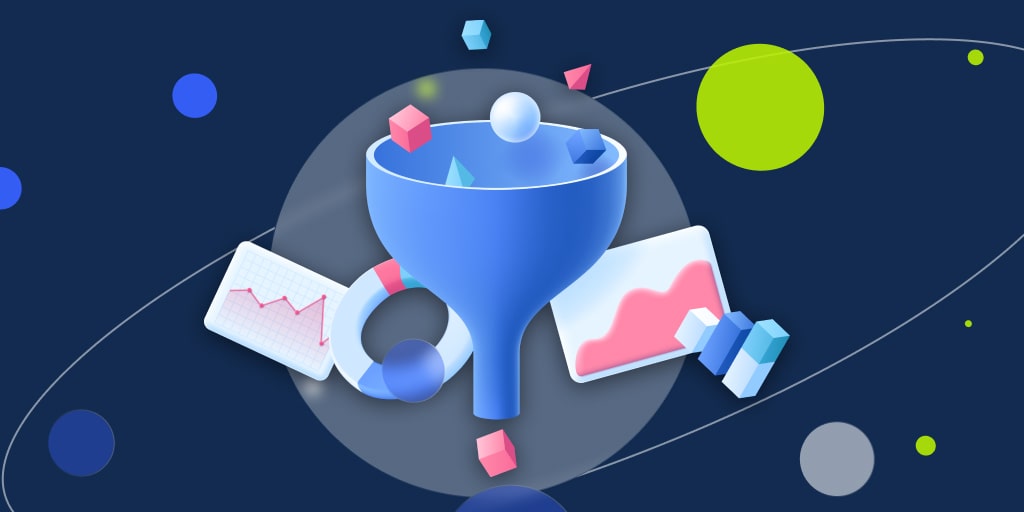
A sales funnel helps any business engage, nurture, and convert leads. Your revenue stream relies heavily on how successful your sales and marketing efforts are. This makes improving and enhancing sales funnel efficiency of high importance. A properly working sales funnel not only helps your business earn customers. It also helps generate referrals and retarget rejections, opening up a new source of business for your company.
If you’re scratching your head because your efforts always seem to fall flat, you’ve ended up on the right article. Here, we will give you tips on how you can make your sales funnel work better for you along with the tools that can help you generate more business.
Before we delve any deeper into how you can maximize sales funnel efficiency, let’s take a closer look at the sales funnel itself. A sales funnel is a representation of a customer’s journey from a lead to a deal. Each stage in the funnel requires particular initiatives and campaigns to coax the customer to the next one until, hopefully, a sale is secured.
The first stage is the top-of-funnel strategies that create awareness of your brand and the products and/or services you offer. All of your content at this stage should be geared toward introducing your company to the general public. Attract leads and prospects by:

Next is the middle-of-funnel engagement where you connect and establish ties with leads. This typically happens after they’ve signed up for your newsletter, subscribed to your email list, or begun following you on social media. At this stage, you can set your brand apart and earn their trust by:
You’ve succeeded in getting the lead’s attention, earned their trust, and nurtured a relationship with them. Now it’s time for the last stage or the bottom-of-funnel conversion. You can convert prospects by giving them specific reasons to choose your brand. Here are some of the initiatives that you can try:
Now that we have all of that out of the way, it’s time to look at how you can maximize sales funnel efficiency.
Knock your sales funnel efficiency out of the park by defining clear and specific objectives for your sales funnel to achieve. These objectives should be in alignment with your broader business goals and desired outcomes. Avoid generalized terms like “growing sales” and define what your ultimate objective is. It can be one of the following things:
If you’re unsure as to what your objectives should be, it’s helpful to look at your current sales process alongside your long-term goals. Then, define what your weak points or areas for improvement are. A few more probing questions about your audience, average sales performance, and close rate, among others, are you should be able to clearly see which area you should focus on.
The fundamentals of sales funnel efficiency include putting in the effort to get to know your audience. Without deeply understanding your target audience’s needs, pain points, and preferences, you will not be able to tailor your sales approach effectively. If you fail at knowing your audience, you won’t know which lead generation and sales strategies to use. Then, your entire campaign along with your messaging, marketing, and attempts at aftersales will fall flat.
Here are some of the things that you can do to get to know your audience:
How did you find/hear of us?
Which part of the shopping experience is your favorite?
Which product or service is the best for you?
To ensure a comprehensive understanding of your customer's experience, it's crucial to create a detailed map of the customer journey from their initial contact as a lead, through their transformation into a consumer, and their development into a returning customer. Mapping the customer journey involves identifying key touchpoints, interactions, and even potential barriers. This process is instrumental in enhancing sales funnel efficiency, as it relies on real examples of successful customer conversions.
The purpose of mapping the customer journey is to gain helpful insight into and potentially predict consumer behavior. It also helps businesses visualize a customer’s progress through the sales funnel and understand the customer experience. Used well, all of the gathered information can help you with sales funnel efficiency.
You can use this guide to create a customer journey map.
After you’ve gotten to know your audience and mapped out your customers’ journey, it’s time to fine-tune your lead generation strategies. The objective is to attract and capture high-quality leads that have a bigger conversion rate and fit your ideal customer profile. All of these lead to better sales funnel efficiency.
Lead generation can be tricky and comes with its own set of obstacles for your team to overcome. However, with the right tools, like a powerful CRM, and the following steps, you should be able to come up with a foolproof lead generation strategy:
Keep in mind that rejections and those that are considered “dead leads” should never be discarded. You can use these as case studies for what works and what doesn’t when it comes to your efforts. What’s more, you can always revisit these when you have a new campaign up to try and convert them instead.
If you’re still processing leads manually, struggling with poor-quality ones, and having problems prioritizing at all, it might be time for lead scoring. Doing this will also ensure sales funnel efficiency. Lead scoring entails assigning values, often numeric points, to each generated lead. These scores will help you in deciding which approach to take, resulting in increased sales funnel efficiency.
There are two types of lead scoring that you can use depending on the audience information that you are able to gather:
Explicit lead scoring uses data you’ve received directly from the lead, such as –
Implicit lead scoring means paying attention to specific behaviors of your leads, including active and passive buying behavior, as well as the following:
Since social media is also often used as a gauge for product and/or service success, you might also want to factor in participation and engagement across all of your platforms. Then, you can score them based on their engagement and readiness to purchase.
Here are a few examples of lead scoring for different activities and behaviors that you can use as a template:
Nothing connects a consumer to a brand better than emotional ties. You can achieve this if you’re able to craft personalized content and experiences. By making your brand relatable, you can guide leads through each stage of the funnel. Personalizing your content also aids in building trust and interest. Sales funnel efficiency will then follow.
You can nurture your leads using several effective methods, including but not limited to:
Content marketing – This is the content you share across all of your channels and platforms, often with links that will guide leads back to your main site. Content marketing should contain focused, relevant, and consistent messaging. All of these should be created without blatantly promoting your brand. It’s about pointing out pain points and creatively angling your products and/or services as the solution. The aim is to turn leads into consumers but also to create value for and build trust in your business.
Retargeting campaigns – Retargeting is mainly aimed at leads who have shown interest in your business without properly engaging or purchasing. Although the concept of retargeting might seem straightforward, it’s more than that. Retargeting requires a bit more clever strategizing and content personalizing. You can’t just inundate your leads with text. The goal should be to stop leads from puttering around, instead committing to purchasing your products or availing of your service. Retargeting is a more targeted marketing approach if you will.
Email blasts – A cost-effective way to engage with your audience is by sending out emails on a regular basis. Some businesses opt to send out 2 emails per week, with the content varying in type. Emails should contain practical information such as guides and eBooks that will create and add value to leads. Injecting additional information about your business will drum up interest, especially if it offers solutions to their current issues and needs. In essence, your emails should be personalized and sent out with the objective of converting passive buyers to active ones.
Utilize automation tools to streamline routine tasks, follow-ups, and communications. They can be especially useful if you’re facing challenges in getting your sales process organized or increasing customer satisfaction. Automation tools also help save time by increasing consistency so you won’t have to constantly keep an eye on deadlines or your online calendars.
With the right tools, there’s no way you can’t accomplish sales funnel efficiency. Here are the sales processes that can be automated:
Prospecting
Pipeline management
Sales and activity tracking
Datacenter
You have already won the game if you have a robust CRM that comes with sales automation tools. You can optimize your team’s skills, keep the sales process clean and always flowing smoothly, and lessen the likelihood of errors. All of these and so much more apart from converting more leads into sales.
It’s always good to take a step back and look at everything you do with fresh eyes so you can take them apart and improve further. For optimum sales funnel efficiency, it’s always sound to continuously monitor and analyze funnel performance. Experimenting with developments and adjustments to enhance efficiency and conversion rates also keeps your approach fresh and interesting.
Analyze your sales funnel efficiency with reports that provide you with definitive results. Monitor sales funnel metrics to identify inefficiencies in your funnel. Reports that give you data on website visits, email open rates, marketing campaign conversions, and lead-to-deal ratio, among others, are essential. Schedule regular meetings with your sales team to go over and review everything before gearing up for a new sales season.
Set aside a specific time for your team to collectively test and evaluate your new initiative or campaign plan. One way to go about this is through A/B testing for funnels. This entails comparing all of the website pages that are part of your sales funnel. From here, you can measure which parts of your site and funnel are effective in converting leads to actual deals. Look out for funnel drop-off points as well so you can eliminate these roadblocks to a successful conversion.
Finally, use the test results and reports that you have to refine what you have. This goes for everything – your website, marketing content, email templates, and everything else sales-related. Evaluate customer feedback for useful recommendations and comments. Keep in mind that your sales funnel efficiency relies on this. Be thorough when reworking your campaign materials before the official release. Double-check with your team to make sure everyone is happy with the changes, and there are no missed recommendations.
Coming up with a winning sales funnel may be a daunting task, but it’s not impossible. All you need is a solid, hardworking team behind you and some of the most fantastic tools and integrations. Really, the best tool you can invest in is a CRM that works just as hard as you do.
Bitrix24 offers just that and more! Project management software, marketing and sales automation, contact center, and CRM all rolled into one. Truly, all you’ll ever need is Bitrix24 and you’re well on your way to brand supremacy. Sign up today so you can enjoy everything Bitrix24 has to offer your business.
The key stages of a sales funnel and their significance include:
Businesses can identify inefficiencies in their sales funnels by:
Some tools and strategies that are essential for optimizing sales funnel efficiency are: